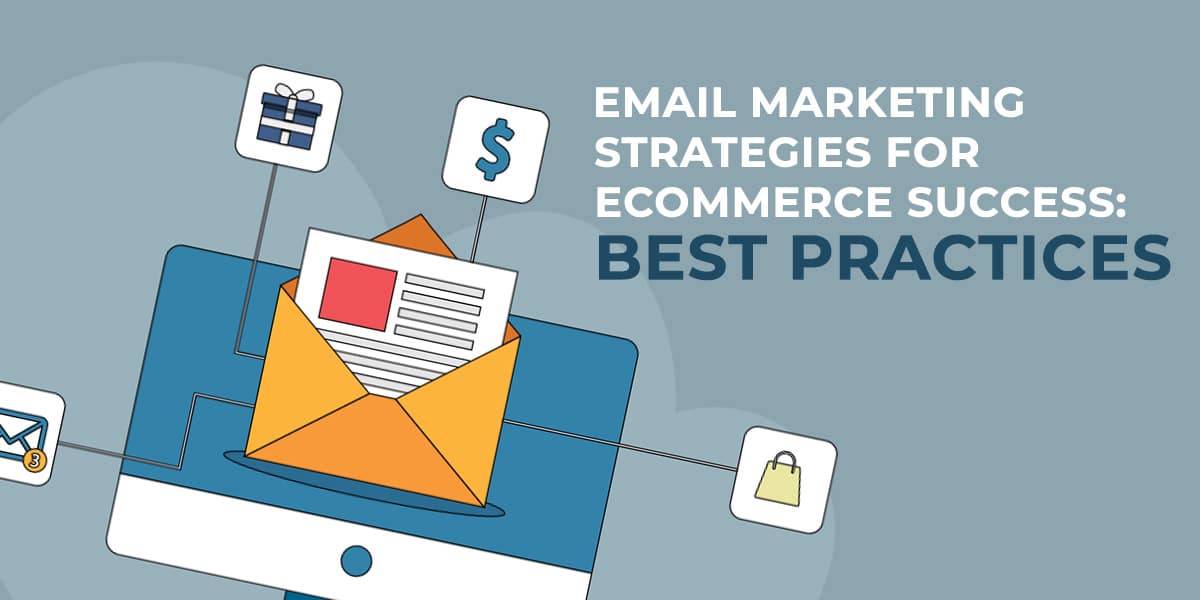Email Marketing Strategies for Ecommerce Success: Best Practices
Email marketing has emerged as a cornerstone for success in the fast-paced world of e-commerce. It is where competition is fierce and customer loyalty is paramount. A well-crafted email marketing campaign has the power to not only drive sales but also build lasting relationships with customers.
In this blog post, we will delve into the essential email marketing strategies tailored for e-commerce businesses, designed to enhance engagement, drive sales, and foster unwavering customer loyalty through effective email campaigns.
Building a Solid Foundation: Email List Building and Segmentation
In the world of e-commerce, where connections are forged in the digital realm, your email list stands as a bridge between your brand and potential customers. The art of email list building isn’t just about accumulating email addresses; it’s about creating a community of engaged individuals who resonate with your brand’s values and offerings.
Below are some highly effective customer retention email strategies to help you build a robust email list, nurturing relationships that drive e-commerce growth.
Effective Strategies for Email List Building:
- Opt-In Incentives: Offering opt-in incentives is akin to extending a handshake of value to your visitors. Whether it’s an enticing eBook, exclusive discounts, early access to sales, or informative webinars, these incentives provide a compelling reason for visitors to share their email addresses willingly.
- Sign-Up Forms: Strategic placement of your email sign-up forms across your website is crucial. Position them on high-traffic pages like the homepage, product pages, and even during checkout. A well-placed sign-up form ensures you capture visitors’ attention at key touchpoints.
- Fostering FOMO with Exclusive Content: Tap into the psychological phenomenon of Fear of Missing Out (FOMO) by promoting exclusive previews of upcoming products, events, or sales to your email subscribers. Make your subscribers feel like insiders with privileged information.
Now, let’s talk about segmentation.
While the notion of building an email list might seem straightforward, its true potential comes to life when paired with strategic segmentation. Your subscribers are not all the same; they have distinct preferences, behaviors, and purchase histories. This is where segmentation steps in as a game-changer.
Check out a few strategies below to get things started.
Strategies for Effective Segmentation:
- Behavior-Based: Group subscribers based on their interactions with your website – whether they’ve abandoned a cart, browsed certain product categories, or made a purchase.
- Purchase History: Tailor emails based on what customers have bought in the past, recommending complementary products or offering discounts on items they might be interested in.
- Engagement Levels: Segment subscribers based on how often they open your emails or click on your links. Engaged subscribers might receive exclusive previews, while those who need re-engagement could receive special offers.
Crafting Compelling Email Campaigns: Content and Design Tips
In e-commerce email marketing, crafting compelling campaigns is an art that blends strategic content and visually appealing design. Let’s delve into a few key strategies to help you create breakthrough email campaigns that stand out in the inbox and drive results.
Content Creation Tips:
- Start with a Strong Subject Line: Your subject line is the gateway to your email. Create curiosity, highlight benefits, or evoke emotions that resonate with your subscribers.
- Engaging Preheader Text: The preheader complements the subject line and provides a sneak peek into the email’s content.
- Compelling Copy: The body of your email should be concise, skimmable, and to the point.
- Clear Call to Action (CTA): Each email should have one CTA that guides readers toward the desired action.
Design Tips:
- Mobile-Friendly Layout: Ensure your design is responsive and easily readable on smaller screens.
- Visual Hierarchy: Highlight the most important elements – like your CTA – through size, color, and placement.
- Consistent Branding: Use consistent colors, fonts, and imagery that align with your website and other marketing materials.
- High-Quality Imagery: Visuals should be crisp, relevant, and support the message.
Personalization and Dynamic Content: Elevating Engagement in E-commerce Email Marketing Campaigns
By integrating dynamic content and personalization strategies into your e-commerce email marketing campaigns, you can captivate your audience and ensure that your messages resonate personally.
The Power of Personalization
By harnessing the power of personalization, you can transform your email communication from generic messages into engaging experiences that cater to individual preferences. It’s not just about addressing recipients by their names; it’s about crafting emails that resonate on a personal level, considering their unique preferences and behaviors. This, in turn, leads to improved open rates, click-through rates, and, ultimately, stronger customer relationships.
The Power of Dynamic Content:
While personalization tailors an email to individual recipients, dynamic content introduces a captivating twist by seamlessly crafting unique experiences for segments within the same email.
This approach is compelling in revolutionizing how you present products or services. Imagine sending an email showcasing products that are curated to align with each recipient’s browsing history or past purchase behavior. Whether passionate about fashion, electronics, or lifestyle essentials, dynamic content ensures that each subscriber is greeted with a personalized array of options that cater to their preferences.
Navigating Cart Abandonment and Re-engagement Strategies
In the world of e-commerce, where browsing and shopping happen at the click of a button, cart abandonment is a challenge every business faces. By implementing a strategy that includes abandoned cart emails and re-engagement email campaigns, you can recover lost opportunities, enhance customer relationships, and ultimately increase conversions.
Abandoned Cart Emails — A Gentle Nudge Back
Seamlessly woven into practical strategies, abandoned cart emails have the power to recover seemingly lost opportunities. You can boost sales through campaigns that gently nudge customers to rediscover the items they left behind and create a simple and clear path toward completing their purchase.
A well-executed abandoned cart email should not only navigate customers back to their abandoned carts but also reignite the excitement that initially led them there.
Re-engagement Campaigns — Tailored Content for Dormant Subscribers
Re-engagement campaigns target subscribers who have become inactive or disengaged over time. Sending tailored content, such as exclusive offers, updates, or valuable resources, can reignite their interest and bring them back into the fold.
Re-engagement can also involve seeking feedback. Sending surveys to abandoned cart customers can provide insights into why they didn’t complete their purchases. This information is invaluable for optimizing your checkout process and addressing potential pain points.
Analyzing and Optimizing Ecommerce Email Marketing Campaign Performance
In the ever-evolving landscape of e-commerce email marketing, success hinges on more than just crafting compelling content and engaging designs. It’s about understanding what works and refining your strategies based on data-driven insights. Analyzing and optimizing your e-commerce email campaign performance is vital in ensuring your efforts yield the desired results.
Let’s explore how you can use the power of data to elevate your email campaigns.
- Track and Measure
Before embarking on any optimization journey, establish a baseline by tracking key performance metrics. Open rates, click-through rates, conversion rates, and revenue generated from each email are valuable indicators of success.
- A/B Testing
A/B testing, or split testing, is a powerful technique for deciphering which elements of your emails resonate best with your audience. By creating variations of your email with single changes – subject lines, CTAs, or visuals – you can identify which version yields higher engagement and conversions. This approach provides tangible insights into customer preferences.
- Segment-Specific Analysis
Different segments of your email list might respond differently to various strategies. Dive into the data to identify trends specific to each segment. Are certain subject lines more effective for one group? Do certain products resonate more with one another? Customizing your approach based on segment-specific data can significantly enhance engagement.
- Content and Visual Analysis
Examine which types of content and visuals resonate most with your audience. Are GIFs generating more clicks than static images? Are video thumbnails enticing recipients to watch? This information guides your content creation process, ensuring you provide what your audience values.
- Customer Journey Mapping
Understanding the customer journey helps you identify the touchpoints where your emails play a role. Analyze how different emails move customers from awareness to consideration and conversion. This enables you to allocate resources effectively and refine your messaging for each stage.
Now, let’s get started!
With the strategies and insights we’ve explored in this blog post, you’re ready to build a strong foundation of e-commerce email marketing. From personalization and segmentation to crafting compelling content and re-engagement strategies to data-driven optimization, you can reshape your brand’s success.
If you want to take your strategy even further, No To The Quo’s expertise can supercharge your e-commerce email marketing success with more advanced email marketing tailored to your business goals and needs. Reach out today, and let’s chat!
Email Marketing No To The Quo



